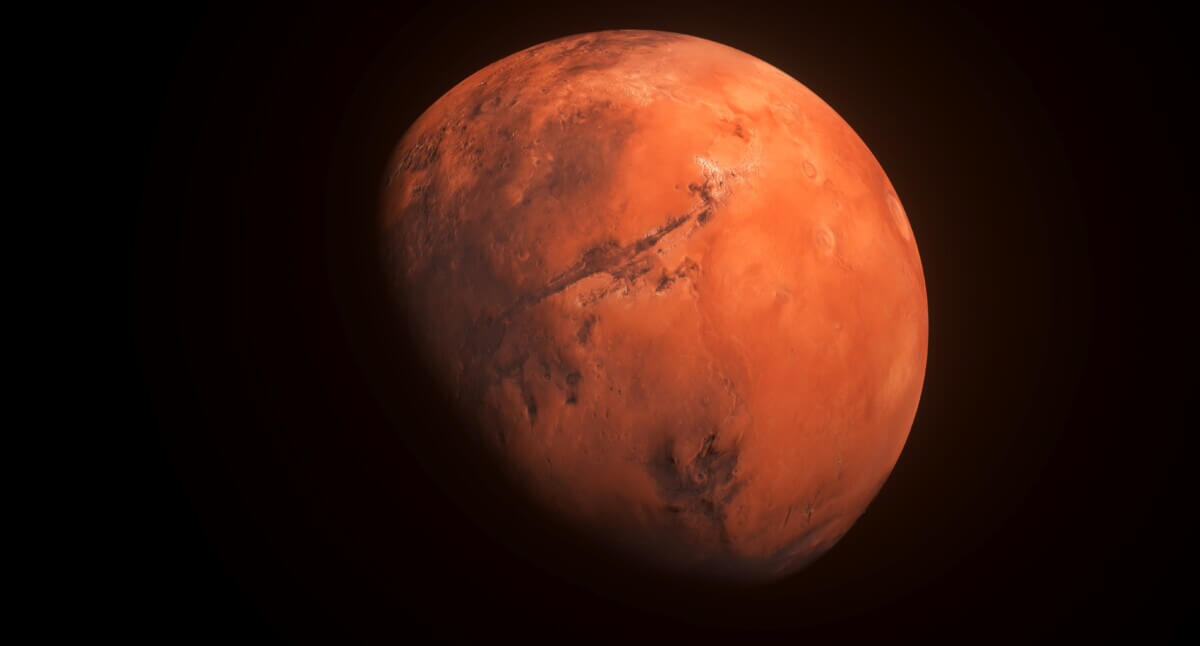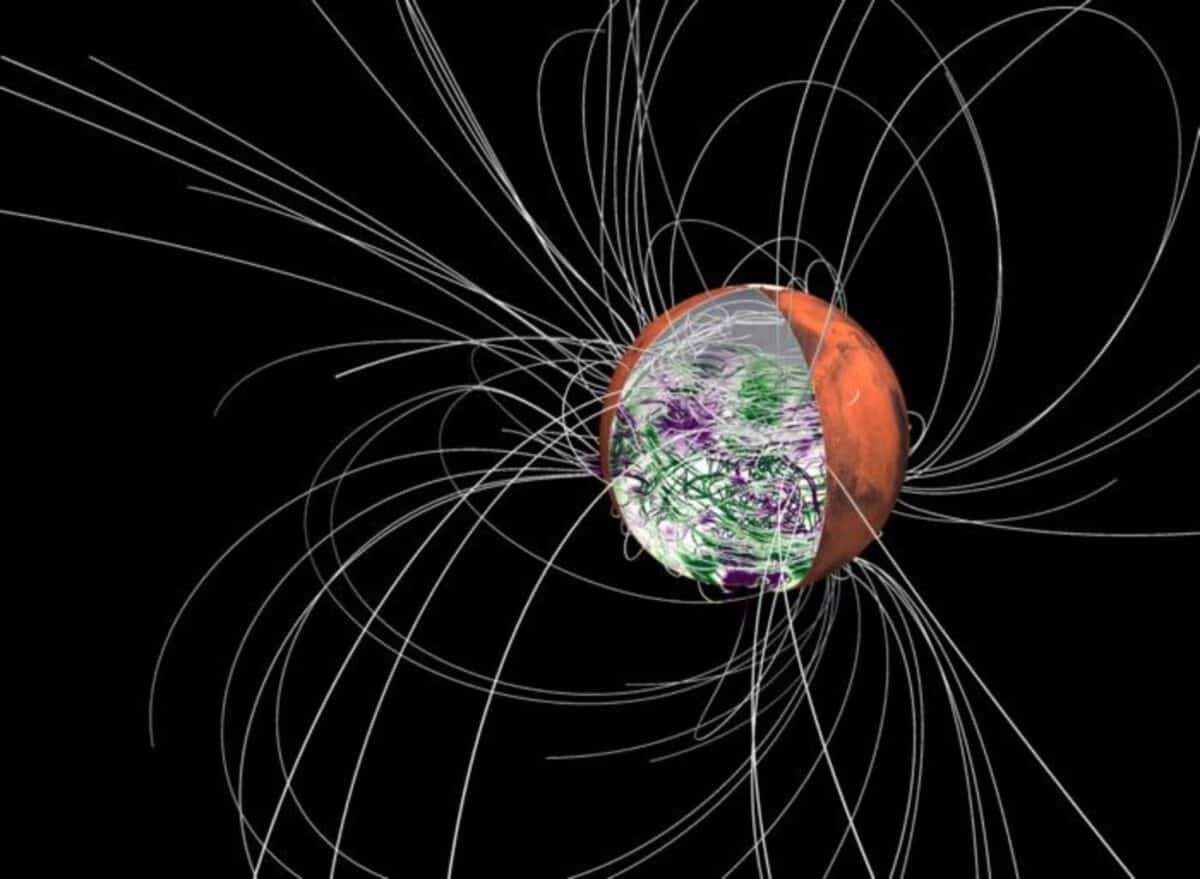
Scientists had long wondered why Mars's magnetic field was stronger in the southern hemisphere when it existed. (© IM_VISUALS - stock.adobe.com)
In a nutshell
- Mars likely never developed a solid inner core during its early history, meaning its magnetic field was generated by a fully molten core, unlike Earth’s layered core structure.
- This all-liquid core helps explain why Mars’ ancient magnetic field was much stronger in the southern hemisphere, solving a decades-old mystery about the planet’s magnetic asymmetry.
- New computer simulations show that even modest heat flow differences across Mars’ mantle could have created the observed magnetic pattern, offering a better match than previous models that assumed a solid inner core.
AUSTIN, Texas — Mars played by different rules than Earth when forming its magnetic field. Rather than generating magnetism with a solid core surrounded by liquid—Earth’s approach—the Red Planet likely created its ancient magnetic shield with an entirely molten core. This revelation from a new study explains why Mars’ magnetic remnants are dramatically stronger in its southern hemisphere, a pattern that has confounded scientists since NASA’s Mars Global Surveyor first detected it.
Scientists from multiple institutions have found that Mars likely never developed a solid inner core during its early history. This new research, published in Geophysical Research Letters, may explain the planet’s odd north-south magnetic field divide, which has been a planetary mystery for decades.
Mars’ Mysterious Magnetic Divide
According to the study, recent seismic data from NASA’s InSight mission reveals Mars’ core is significantly less dense than previously thought. This mission landed on Mars in 2018 and used seismic monitoring to study the planet’s interior structure. The measurements showed Mars’ core contains more lightweight elements than expected, giving it a lower density and melting temperature. This lower density suggests Mars likely maintained a completely liquid core throughout its early history, unlike Earth’s part-solid, part-liquid core structure.

NASA/JPL-Caltech)
Though Mars lacks a magnetic field today, its crustal rocks tell a different story. These rocks formed billions of years ago, preserving evidence that Mars once had a protective magnetic shield similar to Earth’s. But there’s something odd about this preserved magnetism; it’s much stronger in the southern hemisphere than in the northern half of the planet.
To tackle this mystery, researchers built computer models of how Mars’ magnetic field might have formed. But instead of assuming Mars had a solid inner core like Earth, they modeled a “full-sphere” dynamo, which is essentially a completely molten core.
In their simulations, the team tested what would happen if heat escaped unevenly from Mars’ core to its mantle, with more heat flowing out from the southern hemisphere. This uneven heat flow mimics what might have happened if Mars’ mantle was thinner or more heat-conductive in the south.
When heat flowed unevenly from the core, with more escaping from the southern hemisphere, the simulations produced magnetic fields strikingly similar to what we see preserved in Mars’ crustal rocks: stronger in the south, weaker in the north.
The completely molten core models were much better at creating this north-south magnetic divide than models with solid inner cores. To get the same level of magnetic difference between hemispheres, models with solid cores needed heat flow differences more than three times larger than the all-liquid core models.

Ankit Barik/Johns Hopkins University)
Researchers found that magnetic energy behaves differently in these two types of models. In all-liquid cores, magnetic energy concentrates in the outer portions of the core. But in models with solid inner cores, the energy clusters around what scientists call the “tangent cylinder,” an imaginary boundary extending from the inner core.
These differences mean that when the magnetic field extends to Mars’ surface, the all-liquid core produces stronger magnetic fields in the southern hemisphere, matching what we observe in Mars’ rocks.
Scientists believe Earth’s inner core solidified around a billion years ago, meaning our planet once had a fully liquid core too. By understanding how Mars’ magnetic field worked, we might gain insights into early Earth and other rocky planets.
Without a solidifying core releasing energy and buoyancy-driving elements, it’s difficult to explain how Mars maintained its magnetic field for hundreds of millions of years. However, this discovery connects dots across decades of Martian exploration, from surface magnetometer readings to seismic data from the InSight lander. Mars continues to surprise us not by what it has, but by what it lacks—in this case, a solid inner core that Earth takes for granted.
Paper Summary
Methodology
Researchers conducted full-sphere numerical dynamo simulations using the 3D magnetohydrodynamic code MagIC to explore how hemispheric heat flux perturbations at Mars’ core-mantle boundary affected the planet’s ancient magnetic field morphology. The team applied the Boussinesq approximation (where density variations are only considered in buoyancy terms) and modeled various scenarios with different levels of heat flux differences between the northern and southern hemispheres. They then compared these full-sphere model results to traditional spherical shell models that include solid inner cores, examining how both types of models produce hemispheric magnetic fields.
Results
The study found that full-sphere dynamo models (representing a completely molten core) produced more hemispheric magnetic fields than models with solid inner cores. When heat flowed unevenly from the core-mantle boundary—with more heat escaping from the southern hemisphere than the northern—the simulations produced magnetic fields concentrated in the southern hemisphere, closely matching Mars’ observed crustal magnetic field dichotomy. Full-sphere models required significantly smaller heat flux differences to achieve the same level of magnetic asymmetry as models with inner cores. The researchers also discovered that in full-sphere models, magnetic energy accumulates in the outer portions of the core, while in models with inner cores, the energy clusters around the “tangent cylinder” extending from the inner core.
Limitations
The study used non-dimensional parameters that differ significantly from Mars’ actual conditions, particularly regarding viscous forces, which were unrealistically high in the simulations. Further investigation is needed to determine if these findings hold as simulation parameters approach values closer to Mars’ actual conditions. Additionally, the researchers note that the time required for crustal rocks to cool and record magnetic fields varies greatly depending on geological features, which affects how the magnetic field is preserved in the crust.
Funding and Disclosures
The research was funded by the NASA InSight Participating Scientist Program, with additional support from the DLR Management Board Young Research Group Leader Program, the SNSF Ambizione Fellowship, and the Natural Sciences and Engineering Research Council of Canada. The authors used computational resources from the Advanced Research Computing at Hopkins core facility and the Maryland Advanced Research Computing Center.
Publication Information
The paper “Mars’ Hemispheric Magnetic Field From a Full-Sphere Dynamo” was published in Geophysical Research Letters (Volume 52, 2025) and authored by C. Yan, A. Barik, S. Stanley, A. Mittelholz, A.-C. Plesa, and C.-L. Johnson from institutions including the University of Texas at Austin, Johns Hopkins University, Institute of Geophysics (Zurich), German Aerospace Center, University of British Columbia, and Planetary Science Institute. The paper is designated as InSight Contribution No. 305.







